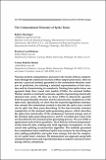The Computational Structure of Spike Trains
Author(s)
Haslinger, Robert Heinz; Klinkner, Kristina Lisa; Cosma, Rohilla Shalizi
DownloadHaslinger-2009-The Computational Structure of Spike Trains.pdf (991.0Kb)
PUBLISHER_POLICY
Publisher Policy
Article is made available in accordance with the publisher's policy and may be subject to US copyright law. Please refer to the publisher's site for terms of use.
Terms of use
Metadata
Show full item recordAbstract
Neurons perform computations, and convey the results of those computations
through the statistical structure of their output spike trains. Here we
present a practical method, grounded in the information-theoretic analysis
of prediction, for inferring a minimal representation of that structure
and for characterizing its complexity. Starting from spike trains, our
approach finds their causal state models (CSMs), the minimal hidden
Markov models or stochastic automata capable of generating statistically
identical time series. We then use these CSMs to objectively quantify
both the generalizable structure and the idiosyncratic randomness of the
spike train. Specifically, we show that the expected algorithmic information
content (the information needed to describe the spike train exactly)
can be split into three parts describing (1) the time-invariant structure
(complexity) of the minimal spike-generating process, which describes
the spike train statistically; (2) the randomness (internal entropy rate) of
the minimal spike-generating process; and (3) a residual pure noise term
not described by the minimal spike-generating process.We use CSMs to
approximate each of these quantities. TheCSMsare inferred nonparametrically
from the data, making only mild regularity assumptions, via the
causal state splitting reconstruction algorithm. The methods presented
here complement more traditional spike train analyses by describing not
only spiking probability and spike train entropy, but also the complexity
of a spike train’s structure. We demonstrate our approach using both
simulated spike trains and experimental data recorded in rat barrel cortex
during vibrissa stimulation.
Date issued
2010-01Department
Massachusetts Institute of Technology. Department of Brain and Cognitive SciencesJournal
Neural Computation
Publisher
MIT Press
Citation
Haslinger, Robert, Kristina Lisa Klinkner, and Cosma Rohilla Shalizi. “The Computational Structure of Spike Trains.” Neural Computation 22.1 (2010): 121-157. © 2010 Massachusetts Institute of Technology.
Version: Final published version
ISSN
0899-7667
1530-888X